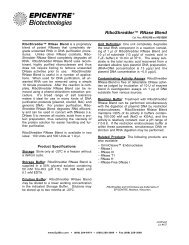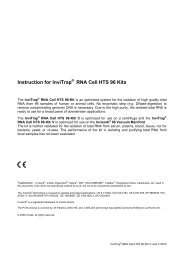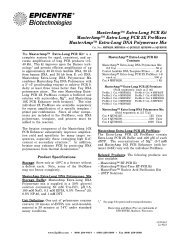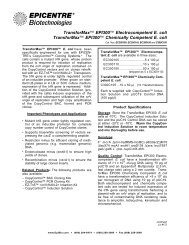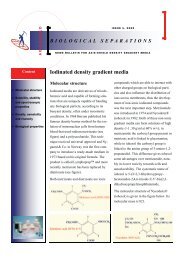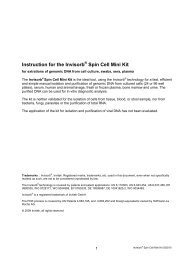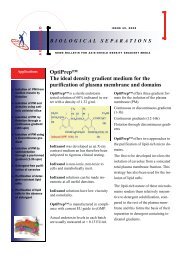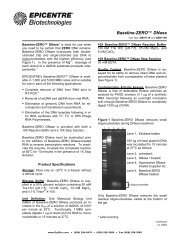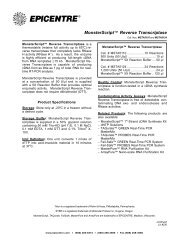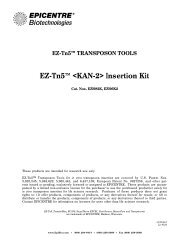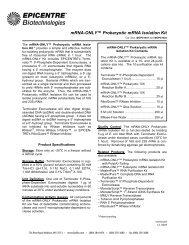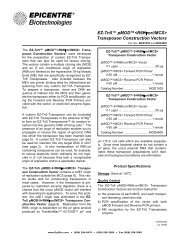Protocol for CopyCutter™ EPI400™ Electrocompetent E. coli ...
Protocol for CopyCutter™ EPI400™ Electrocompetent E. coli ...
Protocol for CopyCutter™ EPI400™ Electrocompetent E. coli ...
You also want an ePaper? Increase the reach of your titles
YUMPU automatically turns print PDFs into web optimized ePapers that Google loves.
EPICENTRE<br />
CopyCutter EPI400 <strong>Electrocompetent</strong> E. <strong>coli</strong><br />
CopyCutter EPI400 Chemically Competent E. <strong>coli</strong><br />
CopyCutter Induction Solution<br />
A. Electroporation of CopyCutter EPI400 <strong>Electrocompetent</strong> E <strong>coli</strong><br />
1. DNA should be in water or very low salt buffer (e.g. TE Buffer: 10 mM Tris-HCl [pH 7.5], 1 mM EDTA)<br />
to prevent arcing during electroporation. The pUC19 Control DNA is provided in TE at 100 pg/µl. If<br />
running a trans<strong>for</strong>mation control, dilute the pUC19 Control DNA 1:10 (to a final concentration of<br />
10 pg/µl) with sterile, deionized water and use 1 µl <strong>for</strong> electroporation.<br />
2. Prepare 1 ml of LB medium (do not include antibiotic in the medium) <strong>for</strong> each electroporation to be<br />
per<strong>for</strong>med. This medium will be used <strong>for</strong> post-electroporation outgrowth of trans<strong>for</strong>med cells. Maintain<br />
the medium at room temperature.<br />
3. Pre-chill electroporation cuvettes.<br />
4. Set-up the electroporation device according to the manufacturer's recommendations <strong>for</strong> bacterial<br />
(E. <strong>coli</strong>) electroporation.<br />
5. Thaw CopyCutter EPI400 <strong>Electrocompetent</strong> E. <strong>coli</strong> cells on ice. Mix by gentle tapping or vortexing.<br />
Use the cells immediately. Unused cells can be refrozen at –70 o C. Note: Refrozen cells may have<br />
reduced trans<strong>for</strong>mation efficiency.<br />
6. Transfer the desired amount of DNA to 50 µl of chilled cells. Note: A smaller volume of cells can be<br />
used based on the needs and experiences of the user. Mix the cells and DNA thoroughly but gently<br />
so as not to introduce air bubbles.<br />
7. Transfer the cell/DNA mix to the electroporation cuvette. Be sure that there are no air bubbles in the<br />
cuvette. Wipe the cuvette of any condensation. Place into the electroporator and apply the electric<br />
pulse at the manufacturer's recommendations <strong>for</strong> bacterial (E. <strong>coli</strong>) electroporation.<br />
8. Immediately after electroporation, add 950 µl of room temperature LB medium [Hanahan, D., (1983)<br />
J. Mol. Biol., 166, 557] to the cuvette. Mix gently by pipetting up and down 2-3 times.<br />
9. Transfer the cells to a 15 ml tube and incubate at 37 o C with shaking at 220-230 rpm <strong>for</strong> 1 hour to<br />
recover the cells and allow expression of the antibiotic resistance marker.<br />
10. Dilute and plate the cells on appropriate medium (e.g. LB agar plates) and antibiotic. For cells trans<strong>for</strong>med<br />
with the pUC19 Control DNA, plate on LB agar containing 100 µg/ml of ampicillin. The<br />
remaining cell outgrowth can be stored at 4 o C in the event additional cell dilutions are plated.<br />
Control (Optional): Dilute the control reaction 1:20 and plate 100 µl (equivalent to 0.05 pg DNA) to<br />
LB-ampicillin (100 µg/ml) plates. If 250 colonies are observed on the plate, the trans<strong>for</strong>mation efficiency<br />
is 5 x 10 9 cfu/ µg or [(250 cfu/0.05 pg DNA) x (10 6 pg/µg)].<br />
page 3




